Insulator Types
by Greg Kareofelas
Reprinted from "INSULATORS - Crown Jewels of the Wire", February 1970, page 3
Few people realize the part insulators played in the
development of the communication and electrical systems
we have today. The start of the electrical age created
the need for insulators, a device to prevent the leakage
of electron flow from the wire or circuit carrier.
Insulators also provided the means of securing the wire
to a pole, house, tree, etc. Modern technology and
plastic insulation has all but replaced the need for
glass and porcelain insulators, but because there were
so many made, insulators will be around for many more
years. Unfortunately, few collectors anymore have the
opportunity to observe insulators actually "insulating".
The purpose of this series of articles is to give
insulator collectors insight into the various settings
that insulators were created for and the variety of
functions they served. This article will be a general
survey of insulators, broken down into major categories
by type and function. More specific articles will follow
in which these groups will be investigated in greater
detail.
We will start by examining the first major group:
Communication Insulators made of glass. Communication
circuits are of low voltage, hence the insulator needed
must be relatively small. A wide variety of styles of
communication insulators have been produced over the
last hundred years, most having one groove and a single
petticoat. Figure 1. lists a few of these types.

Many special types of communication insulators were
created for specific purposes. For example, when two
wires run parallel over a long distance "cross talk"
was produced. It was found that this interference could
be eliminated by transposing the wires. A transposition
insulator was designed for this purpose. Transposition
insulators have two grooves and have been made both
single and double petticoat.

The Brown pony was an insulator designed to double the
carrying capacity of a cross arm. They were patented-by
Mr. Brown in 1886, but evidently were not too popular
for they are not very common today. Brown ponies needed
a special pin to be used properly.
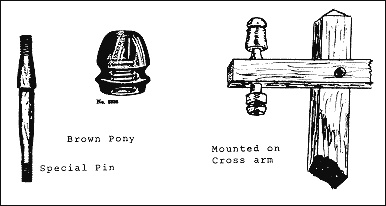
In addition to the normal groove, the double groove
pony was provided with an additional wire groove on the
lower skirt This was for holding the service or drop
line mounting.

A top groove insulator, as its name implies, has an
extra groove on the top. This insulator was for use in
hilly or mountainous country where a top tie provided a
much more secure mounting.
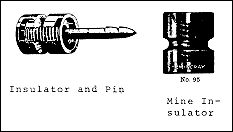
Mine insulators were used to take electricity or
communications deep into a mine. A special pin was
driven into the rock or beams in the ceiling and the
insulator screwed on. The threaded hole in a mine
insulator, went all the way through.
It was found that porcelain provided an effective
insulator, so many of the above types were also
produced in porcelain. These are usually glazed a dark
brown color but reds, blues, and whites are known. The
threads in a porcelain insulator are the same as those
made of glass.
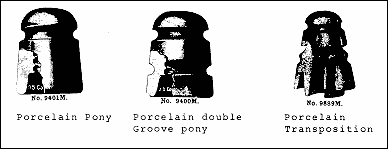
Another style of porcelain insulator commonly seen is
the familiar white "knob". Many sizes were produced to
satisfy a need for a cheap, easy to install, insulator
for low voltage. Many rural lines, still in service,
use this type of insulator. They were mounted by
driving a having a leather washer through the central
hole.
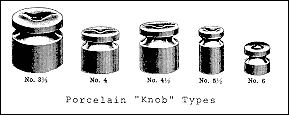
Power insulators were used in the distribution of
electrical power from the generating source to the
ultimate consumer. Large suspension insulators are
familiar, seen hanging from large steel towers.
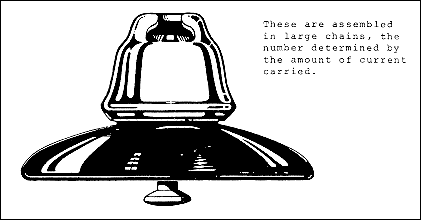
Large porcelain insulators mounted on tall poles are
also well known. Large glass types were made too, but
are rarely seen in service at the present time. The use
of double and triple petticoats is common on these large
insulators. This feature enabled the insulators to carry
a large current more efficiently. A longer path of
resistance was created by these petticoats and they also
provided a dry space when it was raining. Another
feature of high voltage insulators is the wider groove
for the larger wires that had to be carried.
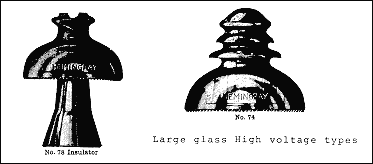
Intermediate, or secondary power distribution insulators
are not so large, the amount of current carried having
been transformed down. These types have the groove
either on the side or on the top, and have been made
from both porcelain or glass.

The power poles outside your home have small power
insulators such as these, again made from either glass
or porcelain (fig a). The service lead, from the pole to
your house, usually ends up tied to a small porcelain
insulator mounted on a galvanized frame (fig b).
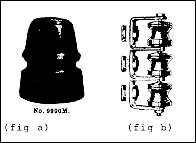
In the past, before the invention of dependable
insulated house wiring, small porcelain insulators were
used in wiring homes and buildings. These were mounted
to rafters and wall studs by nails and held the wire by
compression pressure.
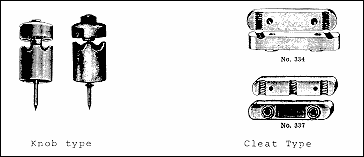
Certain types of insulators were created especially
for use in localities where there were many trees. The
Cutter Tree Insulator was probably the earliest type,
having been patented in the mid 1800's. The split
porcelain type is another example of an insulator for
use forested areas. The two halves were assembled with
the circuit wire in the center, a binder wire wrapped
around it, and then anchored to a tree. These are
still very common in the forested regions of the west.
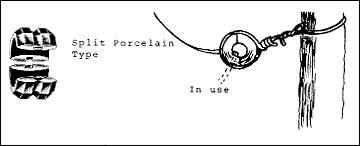
Strain insulators were used to insulate the support or
guy wires used in communication or electrical
construction. Small types were used to make a dead end
or stop. The earliest types were made of glass, but
all modern types are made of porcelain.
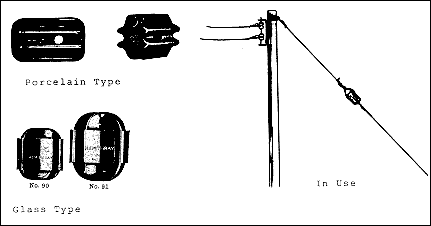
It is hoped that this article has stimulated some
interest into the actual setting that insulators
existed. It is fun to collect insulators for there
color or shape, but as collectors, we should have some
idea as to the reasons the colors and shapes were
created. So, before you pull that next insulator off
the pole, examine how it was mounted and pay attention to clues as to the actual function it was performing
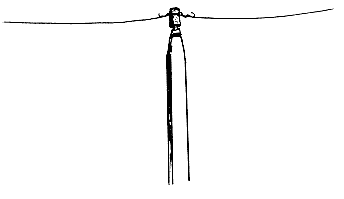
Written by Greg Kareofelas, co-author (with Gary Cranfill) of "The
Collectors'
Guide for Glass Insulators"
with prices revised, also "The Dictionary of
Glass-Ceramic Insulators Reprint."
| 